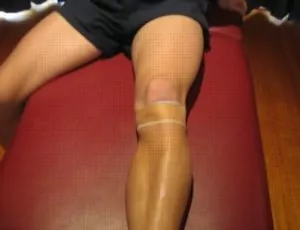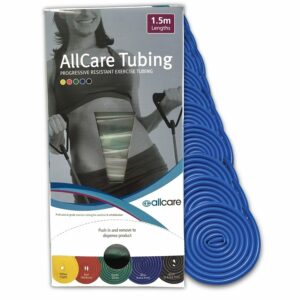Patella Tendon Taping
Updated:
The following patella tendon taping technique is designed to support and reduce stress on the patella tendon (figure 1), during activity. It can be used for both the treatment and prevention of patella tendon injuries such as Patella Tendinopathy and may be useful for patients with Sinding-Larsen-Johansson Syndrome or Osgood-Schlatters Disease.

You should discuss the suitability of this taping technique with your physiotherapist prior to using it. Generally, it should only be applied provided it is comfortable and does not cause an increase in pain, discolouration, pins and needles, numbness, swelling, itchiness or excessive redness of the knee, foot or ankle.
What sort of tape should be used to tape my patella tendon?
There are many different tapes and bandages available for use by physiotherapists and patients. However, when the purpose is to support the patella tendon, 38mm adhesive, non-stretch (rigid) sports tape is usually the most appropriate. This should always be used in combination with hypoallergenic tape as an underlay, such as Fixomull.
Benefits of Patella Tendon Taping
When used correctly, patella tendon taping can:
- Decrease pain during sport or activity
- Aid healing of certain knee injuries
- Allow an earlier return to sport or activity following injury
- Reduce the likelihood of injury aggravation
- Prevent the recurrence of knee injuries (such as a patella tendinopathy) during high risk sports (such as netball, basketball, football, soccer etc.)
Indications for Patella Tendon Taping
It is generally beneficial to tape the patella tendon in the following instances:
- With certain knee injuries – such as patella tendinopathy (this should be discussed with the treating physiotherapist as certain knee injuries should not be taped – such as some fractures).
- To prevent injury recurrence or injury aggravation – Patella tendon taping may be beneficial during sports or activities that place the patella tendon at risk of injury or injury aggravation (such as netball, basketball, football, soccer etc.) especially in patients with a past history of patella tendinopathy.
When should I avoid Patella Tendon Taping?
Patella tendon taping should be avoided in the following instances:
- If you have certain injuries such as some fractures (this should be discussed with the treating physiotherapist).
- If you have a skin allergy to sports tape.
- If the taping technique results in an increase in symptoms such as pain, ache, itchiness, discolouration, pins and needles, numbness, swelling or excessive redness of the knee, foot or ankle.
- If you have sensory or circulatory problems.
Weaning off patella tendon tape in general activity is usually recommended as strength and flexibility improve and symptoms reduce. In these instances though, taping during high-risk activity (such as some sports) is usually still recommended.
Patella Tendon Taping
The following taping technique may be used to provide support for the patella tendon. Generally it is recommended that the knee is shaved 12 hours prior to taping (to prevent painful removal of hairs and skin irritation). The skin should be cleaned and dried, removing any grease or sweat. Low irritant Fixomull tape should be applied as an under-wrap to reduce the likelihood of skin irritation with rigid sports tape over the top of this.
Patella Tendon Taping
Keeping the knee in a slight bend (approximately 30 degrees), tape around the knee just below the knee cap, at the level of the patella tendon (figure 2). Apply the tape firmly to the front of the knee for support and gently at the back of the knee to prevent circulatory problems. 1 – 3 pieces of tape may be used depending on the level of support required.
Occasionally this taping technique may be made more effective by rolling up a small section of tape into a small cylinder and placing it horizontally across the patella tendon and underneath the tape. The size and shape of this cylinder may need to be tailored to the individual to ensure maximal comfort and minimal pain.

Removing the tape
Care should be taken when removing the tape to avoid injury aggravation or skin damage. The tape should be removed slowly, pulling the tape back on itself with pressure placed on the skin as close as possible to the line of attachment of the tape. Generally tape should be removed within 48 hours of application or sooner if there is any increase in pain or symptoms (including skin irritation or itchiness).
Patella Tendon Taping Summary

Members Only ContentBecome a PhysioAdvisor Member to gain full access to this exclusive content. For more details see Become a Member. Already a member? Login Now
 Physiotherapy Products for Patella Tendon Taping & Rehabilitation
Physiotherapy Products for Patella Tendon Taping & Rehabilitation
To purchase physiotherapy products to assist with Patella Tendon Taping click on one of the above links or visit the PhysioAdvisor Shop.
 Knee Exercises
Knee Exercises
- View Knee Stretches.
- View Knee Strengthening Exercises.
- View Balance Exercises.
Other Taping Techniques
- Achilles
- Ankle
- Back
- Calf
- Elbow
- Fat Pad (Infrapatellar)
- Finger
- Foot
- Knee
- Patella
- Patella Tendon
- Posterior Ankle Impingement
- Posture
- Shoulder
- Tennis Elbow
- Thumb
- Wrist
 Find a Physio
Find a Physio
Find a physiotherapist in your local area who can help with Patella Tendon Strapping.
 More Information
More Information
Read about Patella Tendinopathy
Become a Member

Link to this Page
If you would like to link to this article on your website, simply copy the code below and add it to your page:
<a href="https://physioadvisor.com.au/health/taping-techniques-lower-body/patella-tendon”>Patella Tendon Taping – PhysioAdvisor.com</a><br/>PhysioAdvisor offers expert physiotherapy advice on patella tendon taping and strapping.
Return to the top of Patella Tendon Taping.










